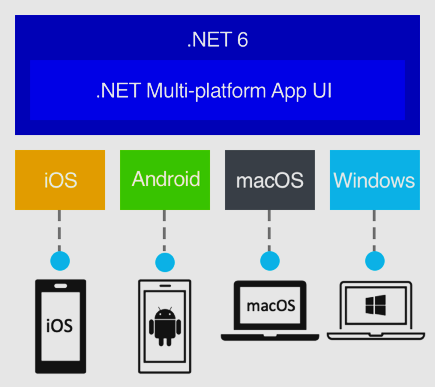Microsoft’s .NET Multi-platform App UI (MAUI), is a next-generation framework for cross-platform app development. MAUI builds upon the success of Xamarin. Forms, offers developers a unified and streamlined approach to creating native mobile applications for iOS, Android, and Windows platforms. With MAUI, developers can leverage their existing skills in C# and XAML to build beautiful and responsive apps that run seamlessly across a variety of devices.
MAUI also introduces exciting new features such as Hot Reload, enabling faster iteration and a more productive development experience. As the successor to Xamarin, MAUI represents Microsoft's commitment to empowering developers with the tools they need to build high-quality mobile applications efficiently and effectively. Apps built using MAUI can run on Android, iOS, Windows and macOS using a single shared code-base built using C# and XAML.

Enterprises/developers use Xamarin extensively, so Microsoft has made sure that the MAUI remains an evolutionary platform over Xamarin. Over the years Microsoft has invested heavily in building MAUI therefore you'll notice many similarities when starting to look into .NET MAUI with Xamarin. Of course, there are differences so as to improve the development experience, performance, and extensibility.
After serving as Microsoft's leading mobile development tool since 2016, Xamarin is nearing the end of its lifecycle. .NET MAUI is now the future for cross-platform mobile app development with Microsoft. The existing projects built in Xamarin must update to the latest release of .NET to remain on a supported version of .NET.
The 6-step guide to migration from Xamarin to MAUI
Moving from Xamarin to MAUI is important for developers because it represents a significant evolution in cross-platform app development. Essentially, it means transitioning from an older framework to a more modern and streamlined one. It's like upgrading from an older version of software to a newer, more efficient one. MAUI offers enhanced capabilities, improved performance, and broader platform support, allowing developers to create high-quality mobile applications more seamlessly across different devices and operating systems. This transition empowers developers to stay at the forefront of mobile app development trends and deliver better user experiences.
Moving applications from Xamarin.Forms to .Net MAUI does not require rewriting the entire codebase. But your developer has to undertake a few code changes. You don't need to rewrite your Xamarin.Forms apps to move them to .NET Multi-platform App UI (.NET MAUI). However, you will need to make some code changes to each app. Similarly, you can use single-project features without merging all of your Xamarin.Forms projects into one project.
To migrate a Xamarin.Forms app to .NET and update the code to .NET MAUI, you'll need to do the following:
Convert Projects:
Shift projects from .NET Framework to the .NET SDK style.
Update Namespaces:
Ensure all namespaces are aligned with the latest .NET MAUI conventions.
NuGet Package Updates:
Update any NuGet packages that are incompatible with .NET MAUI.
Review Platform-Specific Changes:
There might be minor adjustments needed for Android and iOS due to platform-specific aspects.
Address API Changes:
Find and address any API changes that might cause issues.
Test and Verify:
Run the converted app thoroughly to confirm its functionality.
Also, it is advisable not to migrate the entire codebase of your Xamarin.Forms at once. Make sure you do it step-by-step.
Microsoft ended support for Xamarin on May 1, 2024. Here is a summary of the announcement:
- Xamarin.Android, Xamarin.iOS, and Xamarin.Mac is now part of .NET. Existing projects should be upgraded to .NET SDK-style for continued support.
- Xamarin.Forms has become .NET Multi-platform App UI (MAUI). Migrate existing Xamarin.Forms projects to .NET MAUI.
- Existing Xamarin apps will still function but will not receive official support after May 1, 2024.
Connect with us at Nitin.Rajpal@coforge.com to get more details on how to upgrade your existing Xamarin projects to .NET SDK-style and migrate to .NET MAUI. Ensure your apps continue to receive support and stay up-to-date with the latest technologies.
Author | Technical Assistance
Nitin Rajpal | Amit Kumar











